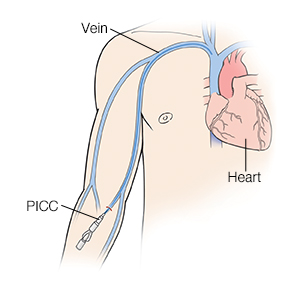Understanding IV Chemotherapy
Intravenous chemotherapy is also called IV chemo. It's done by putting a thin, soft plastic tube (IV catheter) into a vein. This allows the chemo (or other medicines) to go right into your blood and spread through your body. You may have a short-term IV that's removed after each treatment. Or you may have a central venous catheter (CVC). A CVC is put into a large vein during minor surgery. It's left in place as long as needed. Sometimes it's called a central line.
IV chemo can take from a few minutes to many hours. Sometimes it's given as an ongoing (continuous) infusion over a few days. The time it takes depends on the number and type of medicines, and if fluids or other medicines are also being given through the IV.
Short-term IV
A short-term IV is also called a peripheral IV. It's put in your arm, most often between your hand and elbow. A thin needle is used to put it in. You may feel a coolness when the infusion is then started. But it shouldn't burn or hurt. The IV can stay in for a few days but is often taken out when treatment is over.
Over time, chemo can damage your veins, making it hard to place a peripheral IV. If this becomes a problem, a central venous catheter (CVC) can be used. If your treatment plan includes getting chemo for many months, your healthcare provider might suggest you have a CVC put in before starting treatment.
Central venous catheters
 |
| A PICC is one kind of central venous catheter. |
There are three types of central venous catheters (CVCs). They are:
All of these can be left in place for weeks or months. Ports might be left in for years. The benefits of having a CVC are that it:
-
Limits repeated needle sticks
-
May allow more than one medicine to be given at a time
-
Takes away the risk that chemo will leak out of your vein and damage nearby tissues
-
May be used to draw blood, so you're getting fewer needle sticks
The risks include:
-
Infection
-
Blood clots forming in or around the catheter
-
Problems putting fluid into (flushing) the catheter
-
Leaks or breaks in the catheter
-
The catheter coming out
Talk about the risks and benefits with your healthcare provider.
When to call the healthcare provider
No matter which type of IV access you have, call your healthcare provider right away if you have any of these:
-
Itching, rash, hives, wheezing, trouble breathing, or chest pain after treatment
-
Fever of 100.4°F ( 38°C) or higher, taken by mouth, or as directed by your healthcare provider
-
Redness, pain, or swelling at or near the catheter site
-
Swelling, pain, or redness in your arm on the same side as the catheter
-
Fluid leaking or bleeding from the skin around the catheter
-
A catheter that comes out or breaks
Be sure you know how to get in touch with your provider at all times, including when the office is closed.